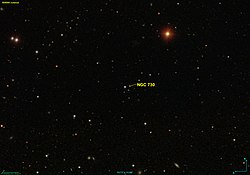| NGC 730 | |
|---|---|
 DSS Image of NGC 730 | |
| Observation data | |
| Constellation | Pisces |
| Right ascension | 01h 55m 17s |
| Declination | ±05° 38′ 10″ [1] |
NGC 730 is a star located in the Pisces constellation discovered on 7 November 1885, appearing around the celestial equator being partially visible to both hemispheres during specific times of the year. [2] [3] [4]